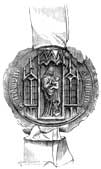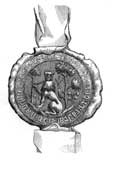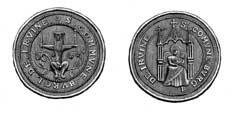 |
||||||||||||||||||||
|
|
||||||||||||||||||||
|
|
||||||||||||||||||||
| THE REBIRTH OF ST. MARY'S PARISH The rebirth of St. Mary's Parish, Irvine, can be traced beyond 1875 to 1862 and even, indeed, beyond that. Mass was said every two months in Irvine, probably in the King's Arms Hotel since 1822 when Father William Thompson was given charge of the Ayrshire mission. He lived in Ayr. From 1845 he was assisted by Father Thomas Wallace. He lived in Kilmarnock and he came to say Mass in Irvine on each fourth Sunday. In 1853 he was succeeded by Father John McLachlan. In 1858-9 he bought a schoolroom and, according to the entry in the 1861 Directory, 'with a few alterations turned it into a neat and convenient little chapel' but when Father Keane arrived in Irvine in February, 1870 this was the building which horrified him so and led him to write so fully to Archbishop Eyre (see later). This schoolroom was known locally as the saltstores, which possibly explains all the chimneys Father Keane complained of. It was situated at the end of West Road at Bridgegate, where the British Linen Bank stood until it was demolished in 1973. |
||||||||||||||||||||
| MARY, PATRONESS OF IRVINE From the acquisition of the saltstores Mass was possibly said in Irvine every Sunday. Like its medieval forerunner, which had been situated on the site of the Old Parish Church, the church was called St. Mary's, in memory of her who had been the patroness of the burgh of Irvine throughout the middle ages, and had been honoured in the yearly celebration of Marymass on 15 August, the feast of her Assumption and whose image even in 1875 was still engraven on the Seal of the Royal Burgh. |
||||||||||||||||||||
|
|
||||||||||||||||||||
| The first illustration depicts the obverse of the Seal of Irvine in 1552. It shows Our Lady, seated and wearing a crown, holding the Christ Child in her arms The incription reads: Sigillum de Irvwyne. |
|
|||||||||||||||||||
| The other illustration depicts the reverse of the same seal. It shows a lion, uncrowned and chained to a tree, with another, taller tree behind it. Unfortunately the inscription is illegible. | ||||||||||||||||||||
|
|
||||||||||||||||||||
|
||||||||||||||||||||
| Between 1660 and 1672 a new seal was made. The reverse bore the lion crowned and carrying a sword and sceptre, and the inscription was: ‘Tandem bona causa triumphat’. The obverse remained the same. The matrix of this seal was kept by the Town Council as late as 1890. |
||||||||||||||||||||
|
|
||||||||||||||||||||
| The rebirth of the parish can therefore be dated 1858-9 but it was in 1862 that Irvine received its own priest, Father William FitzGerald. Unfortunately this tremendous step forward does not seem to have given the satisfaction it should have done, for at the same time the administration of Ayrshire was reorganised and Irvine was attached to North Ayrshire, mainly evangelised from Paisley. Thus the Irvine Catholics lost their connections with Ayr and Kilmarnock. Father FitzGerald was a curate in Dalry and lived there at first even when he was given charge of Irvine. In addition, Kilwinning was added to the parish of Irvine, to the deep disappointment of the Kilwinning Catholics who had themselves hoped to form an independent parish. Father FitzGerald was only twenty-six and newly ordained when he was given charge of this very wide and difficult mission. It was this arrangement which Father Keane blamed for creating the sad state of affairs he found when he arrived in 1870:- 'The plan advocated in 1862 was fundamentally defective and the working out of it has been a miserable failure partly because perhaps of the original defect. Father FitzGerald worked hard and zealously, so much so that when he was unable to pay for a cab to Kilwinning he walked there on Sundays -three miles - returning here in time for Mass at 12 o'clock'. 'What should be done in my humble opinion is to retrace our steps to 1862'. In 1868 Father FitzGerald was replaced by Father Osmund Maguire, a distinguished Passionist. In 1869 he opened a school for fifty pupils, the first Catholic school in Irvine since the Reformation, but it did not last long and in general he experienced the same difficulties as Father FitzGerald. In 1870 he was moved to a Passionist monastery in England, and Father Thomas Keane arrived in Irvine. From 1859 he had been parish priest in Barrhead, where he is buried, and in 1861 he had opened a new church at Neilston. He had also built two new schools, at Nitshill and Neilston. Hence when he came to Irvine at the age of forty-four he was already an experienced parish priest. |
||||||||||||||||||||


